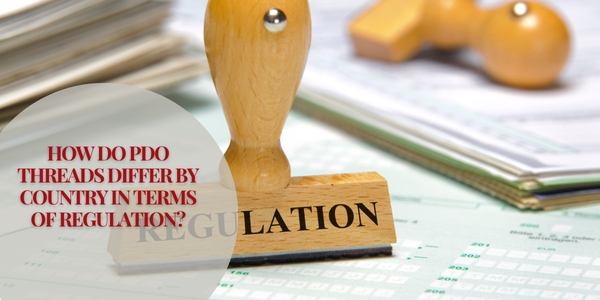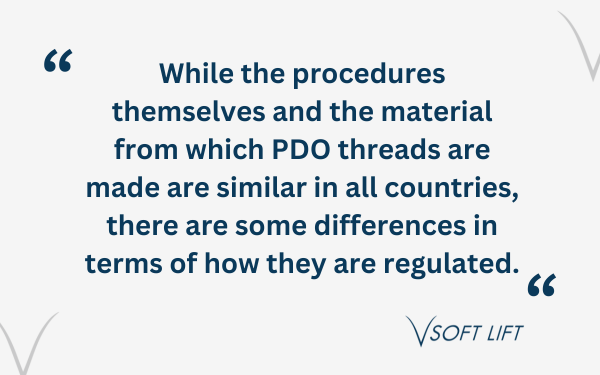
PDO threads have experienced a surge in popularity for cosmetic medicine treatments throughout the world. All across the globe, people are realizing the incredible anti-aging results they provide, all at a fraction of the cost of surgical procedures and without the need to “go under the knife.”
While the procedures themselves and the material from which PDO threads are made are similar in all countries, there are some differences in terms of how they are regulated.

This is an important aspect of PDO threads that you should pay attention to so you can ensure that you are getting only the highest-quality threads for your next treatment.
In this article, we’ll discuss how PDO threads differ by country in terms of regulation.
While the procedures themselves and the material from which PDO threads are made are similar in all countries, there are some differences in terms of how they are regulated.
 Medically reviewed by: Elizabeth Williams RN
Medically reviewed by: Elizabeth Williams RN
Updated: 7/18/2025
United States
In the United States, the Food and Drug Administration is the federal agency responsible for regulating PDO threads. They are classified as Class II medical devices by the agency.
As a Class II medical device, PDO threads are considered FDA cleared. They aren’t fully FDA approved, as that’s terminology that’s only reserved for Class III pharmaceuticals and medical devices.
For PDO threads to be sold and marketed in the U.S. legally, they have to receive what’s known as 501(k) certification. This process checks to ensure that the threads are on par with other existing devices that have already been cleared by the FDA.
In the U.S., any licensed and trained medical provider has the ability to perform PDO thread lifts. That being said, there may be some additional requirements depending on what state you’re in.
Providers don’t have to receive certification from the American Society of Plastic Surgeons to perform thread lifts, since it’s not surgery.
Europe
All medical devices that are sold and marketed in Europe have to receive a CE Marking. This marking tells people that the device is in full compliance with the EU’s safety standards.
In May of 2021, the EU Medical Device Regulation, or MDR, went into full effect. This included stricter regulations on medical devices and increased the scrutiny on devices that are considered high-risk — though PDO threads don’t fall under the latter category.
Under the MDR, manufacturers must adapt documentation and processes, strengthen their clinical evidence about devices, and communicate with appropriate agencies to receive certification.
Asia
Most Asian countries follow similar processes for regulating PDO threads. In most countries, they are considered medical devices and are therefore regulated under the local health authority.
Two countries that have led the way in techniques and technologies for PDO threads are South Korea and Singapore. As such, these two countries have also been at the forefront of regulations surrounding PDO threads.
Unlike in the U.S. and Europe, only trained and registered medical doctors can prescribe a PDO thread treatment for patients, and they are also the only ones who can perform the procedures.
Australia
Australia is just coming up to speed with other countries when it comes to the regulation of PDO threads, with some new regulations set to become effective in September 2025.
The Therapeutic Goods Administration, or TGA, is the agency responsible for overseeing PDO threads products and procedures.
The new guidelines in the country apply not just to PDO threads but to all cosmetic clinics in Australia. They will require providers to go through additional training for certain procedures, emphasize in-depth patient consent and assessments, and also address ancillary services such as aftercare and advertising/marketing.
| Country/Region | Regulatory Agency | Classification | Who Can Perform Procedures | Certification Required | Notes |
|---|---|---|---|---|---|
| United States | FDA | Class II Medical Device | Licensed and trained medical providers (varies by state) | 501(k) Clearance | Not fully FDA approved; ASPS certification not required |
| Europe | Various (EU-wide) | Medical Device with CE Marking | Qualified medical professionals | CE Marking under MDR | MDR effective May 2021; stricter evidence and documentation required |
| Asia (e.g., South Korea, Singapore) | Local Health Authorities | Medical Device | Only trained and registered medical doctors | Varies by country | South Korea and Singapore are industry leaders in regulation and technique |
| Australia | TGA (Therapeutic Goods Administration) | Medical Device | Licensed practitioners with additional training (from 2025) | Upcoming guidelines effective Sept 2025 | New rules emphasize training, consent, aftercare, and advertising |
Use Only the Best PDO Threads from V Soft Lift
PDO threads are gaining popularity throughout the world. As is the case with many other things, PDO threads are treated a little differently in different countries in terms of regulation.
In the United States, PDO threads are considered a Class II medical device and can be cleared for use by the federal agency.
At V Soft Lift, we produce the highest-quality PDO threads on the market. They are FDA cleared for use in the United States, which certifies that they are safe to use.
Our PDO threads produce the best results for patients because providers can select from a long list of products and choose the ones that are optimal for each individual patient’s skin type and treatment area.
For more information, contact us today.
